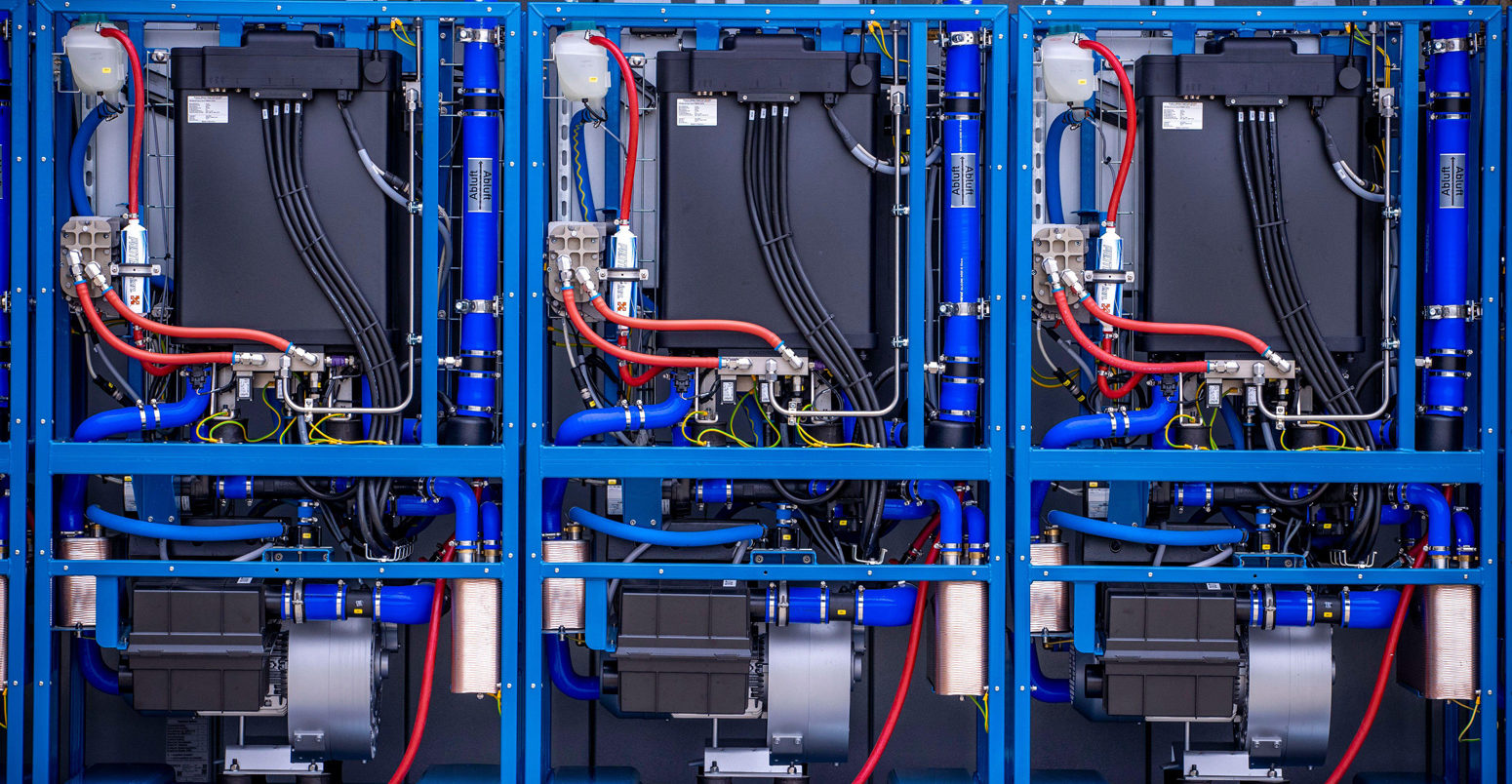
In-depth: Hydrogen ‘required’ to meet UK net-zero goal, says National Grid
Simon Evans
07.29.20Simon Evans
29.07.2020 | 11:54amThe UK will need hydrogen to meet its goal of net-zero greenhouse gas emissions by 2050, according to the latest National Grid “future energy scenarios”.
Hydrogen “could be the solution to many of the hardest parts of the transition to net-zero”, National Grid says, particularly in long-distance freight, shipping and heavy industry.
The annual “future energy scenarios” (FES) sketch out four possible futures for the UK’s energy system until mid-century. This year, there are major changes with three of the four pathways reaching net-zero by 2050. In previous years, most FES scenarios missed the UK’s climate goals.
The three routes to net-zero vary in their level of societal change and reliance on hydrogen, but all require large gains in energy efficiency and heavy electrification of transport. They also see a massive rise in wind and solar power, while fossil gas use for electricity and heating is phased out.
Crucially, however, the report warns that reaching net-zero “requires immediate action across all key technologies and policy areas, and full engagement across society and end consumers”.
Future energy scenarios
Each year, National Grid publishes four scenarios for the UK’s future energy supply and demand, based on its own modelling and consultation with the energy community.
These are designed to help the company plan for the future, in its role as operator of the electricity system for Great Britain [National Grid does not operate in Northern Ireland], as well as owner and operator of the country’s gas transmission network.
[A legally separate entity, National Grid Electricity System Operator, now runs the electricity grid. It is this company that now “owns” the FES publication and modelling work.]
Rather than making singular predictions, the scenarios aim to show a range of “credible” futures, exploring key uncertainties and areas where there is greater confidence in how things will change.
Over time, the reports respond to shifts in politics, technology and society. For example, they have moved to higher levels of renewables and electric vehicles, as technology costs have declined.
In a similar vein, whereas earlier iterations of the report had seen domestic shale gas meeting much of the UK’s future energy needs, the fuel plays no part in the new net-zero pathways. This is, the report explains, “due mainly to reduced support from government and consumers”.
Until 2017, only one of the four FES scenarios published each year complied with the 80% target. In the 2019 report, the net-zero target was only included as a “sensitivity”, with just two of the four main scenarios meeting the UK’s old target of an 80% cut in emissions by 2050.
This year’s report makes several major changes around the UK’s now legally binding target of net-zero by 2050, which is met in three of the four scenarios, shown in the figure below.
National Grid has also started including emissions from agriculture in its modelling, as well as from international aviation and shipping, though emissions from imported goods are excluded.
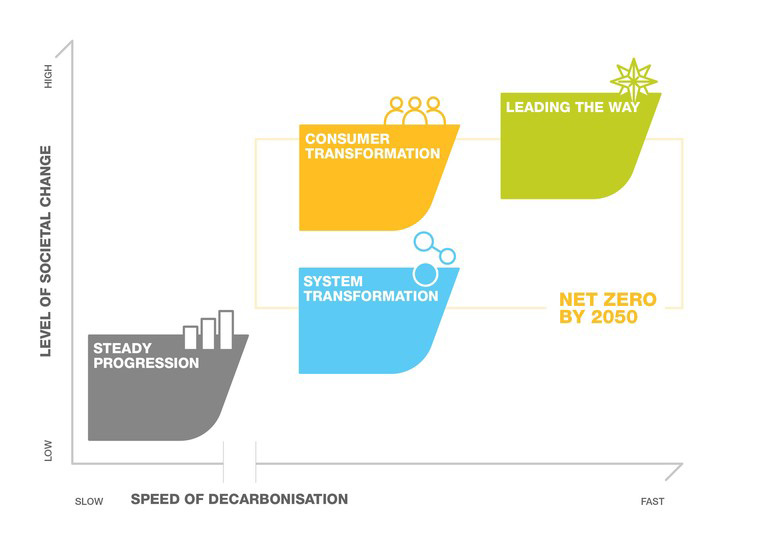
The “Leading the Way” scenario reaches net-zero emissions by 2048, which National Grid describes as the “fastest credible decarbonisation” pathway.
This involves significant levels of societal change, with shifts away from private car use and big improvements in home energy efficiency. The scenarios do not directly tackle diet or land use.
Under “System Transformation”, net-zero is reached by 2050, but peoples’ lives would be affected to a lesser degree. There would be less effort to improve home insulation and smaller changes in transport behaviour, for example.
The energy system would rely heavily on hydrogen derived from imported natural gas, combined with CCS to limit CO2 emissions. Because emissions from imports are excluded, however, this scenario does not account for upstream emissions due to natural gas production.
Energy flows in 2050 under each of the four scenarios are shown in the animation, below.
Hydrogen economy
This year’s shift to scenarios meeting the net-zero emissions target means they rely on much greater climate ambition in all sectors of the economy. To do this, the National Grid pathways use a mix of technological solutions and behaviour change, as noted above.
On the technology side, the report points to hydrogen as having a “much increased role” compared with last year, because of its potential ability to help decarbonise “hard to reach” segments.
This includes heavy goods vehicles, shipping and, in some scenarios, home heating and heavy industry. Hydrogen could also have a role in the power sector as a zero-carbon “dispatchable” source of electricity that can be switched on at will to meet peak demand.
Hydrogen demand in 2050 is shown by sector in the chart, below, under each of the four FES scenarios. These are “Consumer Transformation” (CT), “System Transformation” (ST), “Leading the Way” (LW) and “Steady Progression” (SP), which misses the net-zero goal. (In SP, emissions in 2050 are 258MtCO2e, some 68% below 1990 levels and 46% below levels in 2019.)
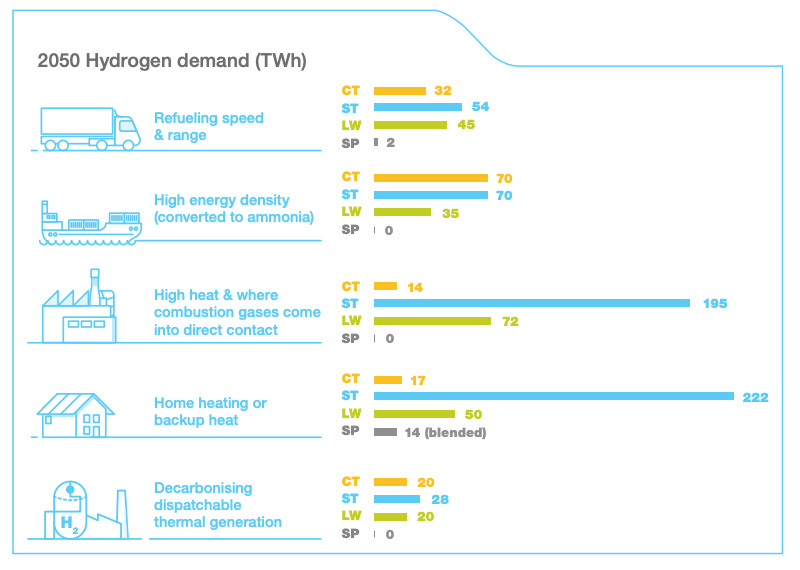
The source of this hydrogen varies between scenarios, reflecting uncertainty about which options will prove most practical and cost-effective. One source is “green hydrogen” from renewable electricity and electrolysis, whereas “blue hydrogen” is from fossil gas with CCS.
Both of these routes entail hefty efficiency losses, meaning that some of the energy is wasted along the way. This means hydrogen is best used where there are minimal alternatives.
Nevertheless, all of the net-zero scenarios use large amounts of the gas, ranging from 152 terawatt hours (TWh) in 2050 up to 591TWh. This is between one-fifth and three-fifths of the total energy needs of the economy. At the high end, it is comparable to current annual demand for natural gas.
For comparison, the UK currently produces around 27TWh of hydrogen each year, according to the Committee on Climate Change (CCC). Its indicative pathway to net-zero used 270TWh of the gas in 2050, mostly blue hydrogen. The committee will publish new advice in December.
The most hydrogen-reliant National Grid scenario is “System Transformation”, in which demand for fossil gas remains relatively constant at just 16% below 2019 levels.
This gas is assumed to be almost exclusively imported from overseas, meaning upstream methane emissions during extraction and transport are not counted towards the UK total. It is converted into hydrogen, with CCS capturing an assumed 97% of the CO2 associated with the process.
In contrast, the other two net-zero scenarios see fossil gas demand falling near to zero by 2050. Fossil gas domestic boilers are phased out under all net-zero scenarios.
(Later this summer, Carbon Brief will be publishing an in-depth Q&A on the promise, potential and pitfalls of hydrogen as a contributor to reaching net-zero emissions.)
Energy efficiency
Another common thread running through all of the net-zero scenarios is a large increase in energy efficiency, which is seen as a prerequisite for meeting domestic and global climate goals.
This is shown in the chart below, where current energy use in the UK (leftmost bar) is compared with levels in 2050. In the three net-zero scenarios in the middle of the chart, demand falls by at least 35% (“System Transformation”) and by as much as 58% (“Leading the way”).
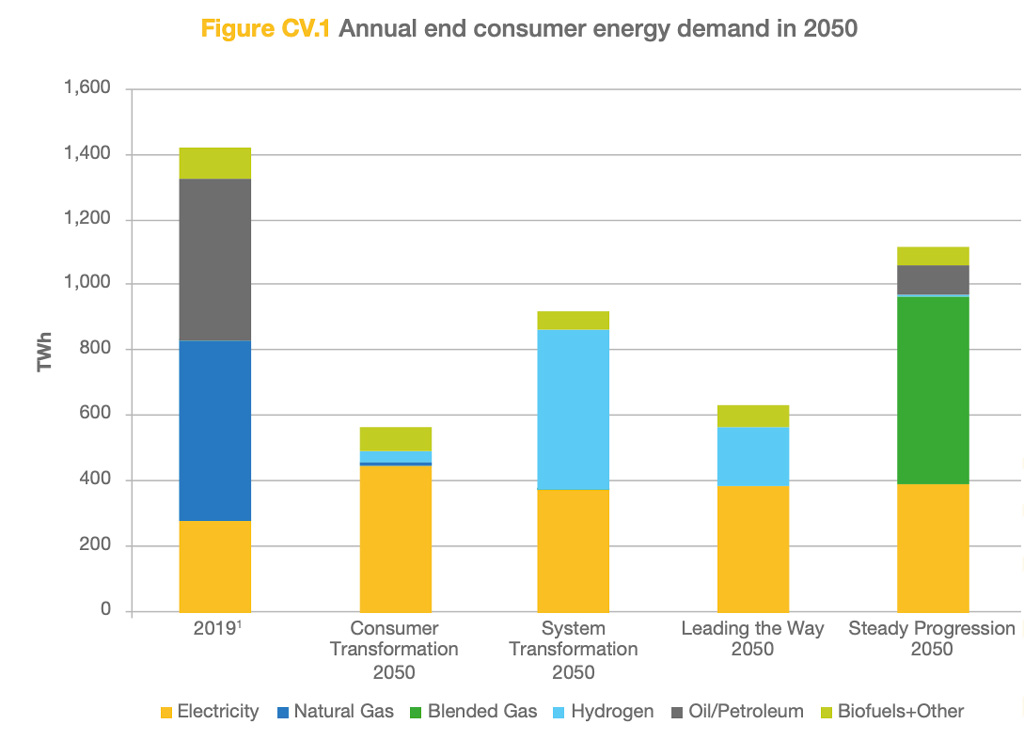
Much of the fall in energy use comes about thanks to better insulation and the use of more efficient appliances. Such changes have already helped to cut UK energy consumption over the past decade, but much faster progress will be needed to make the improvements assumed in the FES.
(In 2019, some 37% of UK homes reached the EPC band C rating for energy efficiency. This reaches 60% by 2035 in some FES pathways and as high as 84% by 2050.)
Ending the use of fossil fuels for heating and transport also offers large energy savings, as combustion engines and boilers are far less efficient than their electric counterparts.
The relative inefficiency of hydrogen-based decarbonisation also explains why “System Transformation” (centre bar, above) uses more energy than the other net-zero pathways.
The FES report says that “electrification is key to the decarbonisation of transport” and sees the number of electric vehicles (EVs) on the road rising to around 30m by between 2040 and 2050. This compares to the current total of 32m cars on the road.
With residual transport energy needs being met by hydrogen, demand for oil falls to zero by 2050 in the net-zero pathways. Neither oil nor coal feature heavily in the FES report.
As in previous years, National Grid suggests that EVs could help balance the electricity grid, by using smart charging to boost their batteries when demand is low and “vehicle to grid” (V2G) technology to feed back into the grid when demand is high.
The report suggests that V2G could supply up to 38 gigawatts (GW) of electricity supply by 2050, during periods of peak demand. This corresponds to nearly two-thirds of the current peak of 58GW.
Electricity generation
The electricity system continues to evolve rapidly under all of the net-zero scenarios, with a backbone of renewable generation. The FES sees “at least” 3GW of wind capacity and 1.4GW of solar capacity being added every year between now and 2050, if net-zero is to be met.
As a result, wind and solar capacity would reach a combined total of 173-206GW by 2050, up from 35GW today. These totals are significantly higher than those in last year’s FES, which had a maximum of 139GW of wind and solar by 2050.
(In one scenario, “Leading the Way”, there is an additional 24GW of offshore wind by 2050 dedicated to hydrogen production at sea, connected to shore via pipeline.)
In the net-zero scenarios, wind and solar are complemented by other low-carbon resources including hydrogen, nuclear and biomass with carbon capture and storage (BECCS).
BECCS is particularly prominent in this year’s report, with at least 8GW of capacity by 2050. Rapid growth of BECCS means the power sector starts to generate “negative emissions” as early as 2030 and no later than 2030 in net-zero pathways. This is shown in the chart below.
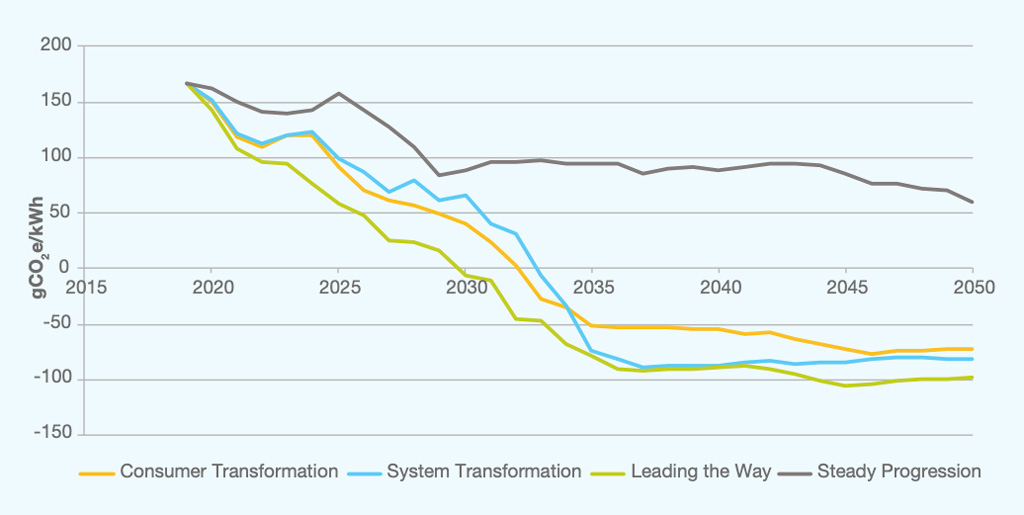
Negative power-sector emissions of as much as 61m tonnes of CO2 (MtCO2) per year by 2050 are used in the scenarios to offset residual releases from elsewhere in the economy. These residual emissions are primarily from aviation and shipping, but also come from agriculture and industry.
The level of negative emissions in the FES, some 49-61MtCO2 of removals per year by 2050, can be compared with the 35MtCO2 in the CCC’s indicative net-zero pathway published last year.
In order to accommodate the very high levels of wind and solar in the net-zero pathways, National Grid looks at various options for flexibility, including EV smart charging and V2G mentioned above.
Electrolysers using excess electricity to make hydrogen are another important source of flexibility in the FES pathways. Capacity climbs from less than 1GW today to as much as 10GW by 2035 and 73GW by 2050, with the higher end meaning less fossil gas is used to make hydrogen.
As early as 2035, there is also 20GW of electricity storage capacity such as batteries and pumped hydro – up from 3.8GW today – with the total reaching up to 40GW by 2050.
Unlike in previous years, the FES sees no long-term role for gas-fired power stations fitted with CCS. Instead, the role previously filled by these plants is met by hydrogen generators.
Nuclear continues to play a role in the net-zero pathways, but its prospects vary widely. Today, the UK has around 9GW of nuclear capacity. By 2050, National Grid sees this changing to as low as 5GW or as high as 17GW, depending on the scenario. At the low end, this would see Hinkley Point C in Somerset as the only large new nuclear plant built in the UK over the next 30 years.
National Grid is to continue its research programme on “bridging the gap to net-zero”, with a second round launching in autumn 2020.
This work aims to explore the most important and uncertain parts of the future energy scenarios, identifying immediate policy priorities to help unlock progress towards net-zero emissions. In the first round of this work, the focus was on three areas, with the findings reflected in this year’s FES.
The 2019 focus areas were: on the amount and best use of sustainable bioenergy that will be available to the UK; the role of electric vehicles in aiding renewable energy integration; and how to manage peak demand for electrified heat in winter.
-
In-depth: Hydrogen ‘required’ to meet UK net-zero goal, says National Grid
-
UK can reach net-zero by 2048, National Grid says

